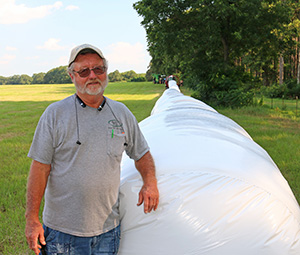Bag It Up – Making Hay In A Different Way

Colin Wilson and Jim Waite live on opposite ends of the state, but both capitalized on Alabama’s frequent rainfall this summer by baling haylage to feed their cows in winter.
“Baling haylage allows me to get hay off the ground quicker between rain showers,” said Wilson, 38, of Hollywood in Jackson County. He typically bales 1,000 rolls of haylage plus 500 dry-hay bales annually to feed his 300 head of brood cows.
Dry hay and haylage (sometimes called balage) are techniques for storing forage, but differ in moisture content.
Haylage is high-moisture forage wrapped in plastic and typically baled when its moisture level is around 40-60 percent. It can be baled in as little as five hours after cutting.
Dry hay may take 24 hours or longer to reach its ideal moisture level of 15-20 percent.
“Cows digest haylage easier because plant cells have already broken down,” Wilson said. “Its nutritional value is 2 percent higher than dry hay, which makes haylage more palatable for cows.”
When comparing various methods of storing forage, it’s important to remember a farmer’s goal — to produce the best quality hay possible, said Nate Jaeger.
“The quality of haylage will only be as good as what goes into the bag,” said Jaeger, the Alabama Farmers Federation’s former Hay and Forage Division director. “Haylage allows for cutting high-quality forages at the proper time to maintain high percentages of total digestible nutrients.”
Growers can harvest and wrap haylage faster because of the reduced time to dry (or cure), Jaeger said, but the bagging system won't work for hay that's been rained on.
High-moisture hay refers to the percentage of water inside the plant, not the outside, he added.
In Andalusia, dairy farmer Jim Waite has been in the hay business for over 30 years. He first began using haylage to feed his dairy cows and later his beef cattle. Waite was such a believer, he began selling haylage equipment throughout the Southeast.
He said haylage farmers can harvest one or two more cuttings annually than with dry hay.
“Since I don’t have to wait on the weather, I can cut hay at its proper maturity,” Waite said. “Cutting at the right maturity enables me to preserve more nutrients and cut more often.”
Haylage is encased in stretched plastic to lock in moisture. The bags can be individual rolls or long tubes. In-line wrappers package bales in rows with caps sealing each end.
Individual bale wrappers use 40 percent more plastic.
Wilson and Waite agree the overall benefits of haylage are worth the added cost of equipment — around $30,000 for an in-line wrapper.
Wilson also said haylage improves profits for his cattle farm.
“Haylage provides my calves with extra nutrients they would miss if being fed dry hay alone,” he said.
For more information about haylage, contact a local Cooperative Extension agent.
